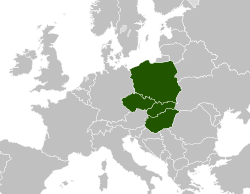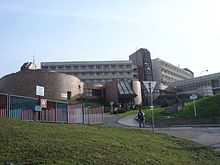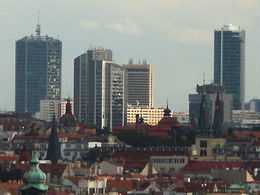Visegrád Group
Visegrad Group |
||
|---|---|---|
 Map of Europe indicating the four member countries of the Visegrad Group.
|
||
| Membership | ||
| Leaders | ||
| - | Rotating Presidency | |
| Establishment | 15 February 1991 | |
| Area | ||
| - | Total | 533,615 km2 206,030 sq mi |
| Population | ||
| - | 2010 estimate | 64,301,710 |
| - | Density | 120.0/km2 310.8/sq mi |
| GDP (PPP) | estimate | |
| - | Total | $1,452,062 billion |
The Visegrád Group, also called the Visegrád Four, V4, or European Quartet is an alliance of four Central European states – Czech Republic, Hungary, Poland and Slovakia – for the purposes of cooperation and furthering their European integration further military, economic and energy cooperation. The Group's name in the languages of the four countries is Visegrádská čtyřka or Visegrádská skupina (Czech); Visegrádi Együttműködés or Visegrádi négyek (Hungarian); Grupa Wyszehradzka (Polish); and Vyšehradská skupina or Vyšehradská štvorka (Slovak). It is also sometimes referred to as the Visegrád Triangle, since it was an alliance of three states at the beginning – the term is not valid now, but appears sometimes even after all the years since the dissolution of Czechoslovakia in 1993.
The Group originated in a summit meeting of the heads of state or government of Czechoslovakia, Hungary and Poland held in the Hungarian castle town of Visegrád[2] on 15 February 1991 (not to be mistaken with Vyšehrad, a castle in Prague, the capital city of the Czech Republic, or with the town of Višegrad in Bosnia and Herzegovina).
The Czech Republic and Slovakia became members after the dissolution of Czechoslovakia in 1993. All four members of the Visegrád Group became part of the European Union on 1 May 2004.
Historical inspiration
The name of the Group is derived, and the place of meeting selected, from a meeting of the Bohemian, Polish and Hungarian rulers in Visegrád in 1335. Charles I of Hungary, Casimir III of Poland and John of Bohemia agreed to create new commercial routes to bypass the staple port Vienna and obtain easier access to other European markets. A second meeting took place in 1339, where the new king of Poland was decided upon.
Economies
All four nations in the Visegrád Group were high income countries with a very high Human Development Index, until Hungary dropped recently. V4 countries have enjoyed more or less steady economic growth for over a century.[3] In 2009, Slovakia adopted the euro as its official currency.
If counted as a single nation state, the Visegrad Group is the seventh largest economy in Europe and the 14th in the world.
Based on Gross Domestic Product (PPP) figures for the year 2011, the most developed country in the grouping is the Czech Republic (USD $27,662[4] per capita), followed by Slovakia (USD 24,971 per capita), Poland (USD 21,005 per capita) and Hungary (USD 19,998 per capita). The average GDP (PPP) in 2013 for the entire group was USD 22,582.
Within the EU, the V4 countries are pro-nuclear power, and are seeking to expand or found (in the case of Poland) a nuclear power industry. They have sought to counter what they see as an anti-nuclear power bias within the EU, believing their countries would benefit from nuclear powers zero emissions and high reliability.[5] [6]
Poland

Poland has the region's largest economy (GDP PPP total of USD 824,783 billion, ranked 19th in the world). According to the United Nations and the World Bank, it is a high-income country with a very high human development index.[7][8] The Polish economy is the sixth largest in the EU and one of the fastest growing economies in Europe, with a yearly growth rate of over 3.0% before the late-2000s recession. It is the only member country of the European Union to have avoided a decline in GDP, meaning that in 2009 Poland has created the most GDP growth in the EU. As of December 2009 the Polish economy had not entered recession nor contracted. According to the Central Statistical Office of Poland, In 2011 the Polish economic growth rate was 4.3%, which was the best result in EU. The largest component of its economy is the service sector (67,3%), followed by the industry sector (28,1%) and the agriculture sector (4,6%). Today, the main obstacle to growth is the country's poor infrastructure. However, with the increase of private investment and funding assistance from the EU, infrastructure in Poland is rapidly improving.
The main industries are mining, machinery (cars, buses, ships), metallurgy, chemical, electrical, textile and food processing. The high technology and IT sectors are also growing with the help of investors like Google, Toshiba, Dell, GE, LG and Sharp. The result is that today Poland is a producer of many electronic devices and components.[9] Minerals extracted include black and brown coal, copper, lead, zinc, salt, sulfur, magnesite, kaolin and small amounts of oil and natural gas. The recently made available US Department of Energy report revealed that the largest reserves of shale gas in Europe are in Poland and it is expected that its production will play an important role in the Polish economy in the near future.[10]
Poland has been called the bread basket of Europe due to its highly developed agriculture sector. Arable lands make up nearly half of the country, meadows and pastures only 13% and forests 30%. Wheat, rye, barley, flax, oats, potatoes, sugar beets, canola, hops, fruit and vegetables are all grown for both the home and export markets. Meanwhile, Poland's production of rye, flax, potatoes and sugar beet is the second largest in Europe after Russia. Pigs, cattle, sheep, horses and poultry are all commonly bred livestock. The country also has a substantial fishing industry located on the Baltic coast and near the lakes of the Mazury region.
Czech Republic
The Czech Republic's economy is the group's second largest (GDP of USD $292,537 billion[4] total, ranked 42nd in the world). Before the Second World War, the Czech Republic was one of the most advanced countries in the world. However, the subsequent 41 years of socialism with communist leadership greatly damaged the economy. Since the Velvet Revolution, the Czech Republic has successfully transformed itself into a free market economy. Today, the Czech Republic is a highly industrialized country and is, according to the World Bank, one of the world's thirty most developed countries. The main problems it faces are corruption and inequality between regions.
The principal industries in the Czech Republic are chemicals, machinery, food processing, metallurgy and smelting. Other major industry sectors are energy, construction and consumer. Less important are the arms industry and glass, but these have a long tradition in Bohemia. Industry accounts for 35% of the Czech economy. The Czech Republic produces per capita the most cars in the world and about the same amount as in Great Britain. Main producers are Škoda auto, Peugeot-Citroen, Toyota and Hyundai. Other major companies are ČEZ (biggest company in central and eastern Europe), Škoda works (manufacturer of rail vehicles), Panasonic (electronics), Tatra (Heavy truck manufacturer), Arcelor Mittal (Metallurgy), Avast (Software), PPF (largest Central European investment group) Pilsner Urquell (brewing) Aero (aerospace) and many others.
In the Czech Republic is the headquarters of the Galileo project.
The key minerals mined are black and brown coal, clay, graphite, limestone and other building materials. Uranium deposits are found near the village of Lower. In South Moravia, oil and natural gas are extracted, but larger amounts are imported from Russia. Since one third of the country is covered with forest, wood is also an important export.
Cereals (wheat, barley, maize), potatoes, sugar beets, poppy seeds, other flax crops, and canola are grown. Hops, fruit growing and viticulture are also important. The basis of livestock is cattle, pigs and poultry, as well as beekeeping or freshwater fish (especially carp).
Hungary

Hungary has the group's third largest economy (total GDP of USD 198,822 billion, 52nd in the world). Hungary was one of the more developed economies of the Eastern bloc. With about $18 billion in foreign direct investment (FDI) since 1989, Hungary has attracted over one-third of all FDI in central and eastern Europe, including the former Soviet Union. Of this, about $6 billion came from American companies. Now it is an industrial agricultural state. The main problem is generally declining economic performance and high debt.
The main industries are engineering, mechanical engineering (cars, buses), chemical, electrical, textile and food industries.
The service's sector accounted for 64% of GDP in 2007 and its role in the Hungarian economy is steadily growing. Located in the heart of Central-Europe, Hungary’s geostrategic location plays a significant role in the rise of the service sector as the country’s central position makes it suitable and rewarding to invest.
The main sectors of Hungarian industry are heavy industry (mining, metallurgy, machine and steel production), energy production, mechanical engineering, chemicals, food industry and automobile production. The industry is leaning mainly on processing industry and (including construction) accounted for 29.32% of GDP in 2008. The leading industry is machinery, followed by chemical industry (plastic production, pharmaceuticals), while mining, metallurgy and textile industry seemed to be losing importance in the past two decades. In spite of the significant drop in the last decade, food industry is still giving up to 14% of total industrial production and amounts to 7-8% of the country's exports.
Agriculture accounted for 4.3% of GDP in 2008 and along with the food industry occupied roughly 7.7% of the labor force. These two figures represent only the primary agricultural production: along with related businesses, agriculture makes up about 13% of the GDP. Hungarian agriculture is virtually self-sufficient and due to traditional reasons export-oriented. The most important crops are wheat, corn, sunflower, potato, sugar beet, canola and a wide variety of fruits (notably apple, peach, pear, grape, watermelon, plum etc.). Hungary has several wine regions producing among others the worldwide famous white dessert wine Tokaji and the red Bull’s Blood.
Tourism employs nearly 150 thousand people and the total income from tourism was 4 billion euros in 2008. One of Hungary’s top tourist destinations is Lake Balaton, the largest freshwater lake in Central Europe, with a number of 1,2 million visitors in 2008. The most visited region is Budapest, the Hungarian capital attracted 3.61 million visitors in 2008.Hungary was the world’s 26th most visited country in 2007.
Slovakia

The smallest V4 economy is that of Slovakia (GDP of USD 135,920 billion total, 60th in the world). Along with the Czech Republic, Slovakia was the most developed country of the Eastern Bloc. The first years after the revolution in 1989 saw stagnation. At the end of the 1990s, the economy grew and attracted much investment. Today Slovakia is an advanced industrial nation.
The automotive industry is important to the Slovak economy. Cars produced are Volkswagen, Peugeot, Citroen and Kia. Another important industry is electronics. Near the city of Nitra is Sony's Japanese factory. The Korean company Samsung also has a factory in Slovakia. The metals, mining and quarrying and food-processing industries are important. Slovak industry has good prospects and is expected to grow rapidly.[citation needed]
Slovakia has a developed agriculture. Mostly grown is corn, but also wine, especially in Bratislava. In the Tatra Mountains and other high land there is breeding of domestic animals - sheep and cattle. Peppers and potatoes are grown.
Demographics
The population is 64,301,710 inhabitants, which would rank 22nd largest in the world and 4th in Europe if V4 was a single country. Most people live in Poland (38 million), followed by the Czech Republic (nearly 11 million), Hungary (nearly 10 million) and Slovakia (5.5 million).


Rotating presidency
The country holding the Group's presidency changes each year, in June:
|
|
|
|
|
|
International Visegrad Fund

The only organization of the Visegrad co-operation is the International Visegrad Fund, established in 1999, with its seat in Bratislava. According to a decision of the prime ministers, the Fund has an annual budget of EUR 8 million as of 2014. With more than 11 annual deadlines and irregular calls for proposals the fund awards grants, scholarships and research fellowships, and artist residencies. Main recipients of its funding are citizens and non-governmental organizations from the V4 region, as well as countries of the Western Balkans, the Eastern Partnerships, and other countries.
Initiatives
Visegrád Battlegroup
On 12 May 2011, Polish Defence Minister Bogdan Klich said that Poland will lead a new battlegroup of the Visegrad Group. The decision was made at the V4 defense ministers' meeting in Levoca, Slovakia, and the battlegroup would become operational and be placed on standby in the first half of 2016. The ministers also agreed that the V4 militaries should hold regular exercises under the auspices of the NATO Response Force, with the first such exercise to be held in Poland in 2013.
Visegrad Scholarship Program
The continually expanding Visegrad Scholarship Program awards individual mobility stipends from the International Visegrad Fund for students of Master's or post-Master's levels. Students from the following countries and territories are eligible for the scholarships: the Visegrad Group countries (Czech Republic, Hungary, Poland and Slovakia), also Albania, Armenia, Azerbaijan, Belarus, Bosnia and Herzegovina, Georgia, Kosovo, Macedonia, Moldova, Montenegro, Serbia, Russia, and Ukraine.
Expert Working Group on Energy
In 2002, Hungary initiated establishment of an Expert Working Group on Energy. This expert group meets once or twice a year in V4 capitals on a rotation basis, and the head of the host country delegation always chairs the meeting.
On 27 April 2006, the V4 WG on Energy met in Prague with the aim of discussing recommendations for V4 energy ministers concerning topics negotiated at ministerial level meetings. The WG elaborated recommendations concerning four groups of problems:
- Recommendations of general nature in the sphere of energy policy, including energy research and development.
- Recommendation to consider development of emergency natural gas storage.
- Recommendation to consider construction of new gas and oil pipelines and of new naval LNG terminals.
- Recommendations in the field of interconnecting power transmission grids.
See also
References
- ↑ Official website
- ↑ Engelberg, Stephen (17 February 1991). "Three Eastern European Leaders Confer, Gingerly". The New York Times. Retrieved 11 April 2009.
- ↑ Aggregate And Per Capita GDP in Europe, 1870-2000: Continental, Regional and National Data With Changing Boundaries, Stephen Broadberry University of Warwick (27 October 2011), Retrieved on 07 September 2013
- ↑ 4.0 4.1 "Czech Republic". International Monetary Fund. Retrieved 10 October 2012.
- ↑ http://www.china.org.cn/world/Off_the_Wire/2013-10/14/content_30291509.htm
- ↑ http://www.world-nuclear-news.org/NP-Dont_impede_our_nuclear_V4_tells_EU-1510138.html
- ↑ World Bank high-income economy - Wikipedia, the free encyclopedia. En.wikipedia.org. Retrieved on 2013-07-19.
- ↑ Human Development Index - Wikipedia, the free encyclopedia. En.wikipedia.org. Retrieved on 2013-07-19.
- ↑ Toshiba Invests in a Subsidiary of LG.Philips LCD in Poland. eCoustics.com (2006-10-10). Retrieved on 2013-07-19.
- ↑ Shale gas - Wikipedia, the free encyclopedia. En.wikipedia.org. Retrieved on 2013-07-19.
External links
- Official portal of the Visegrád Group
- Official travel site of the Visegrád Group
- International Visegrád Fund official homepage
- Visegrad Insight - Analysis and opinion journal edited by editors from V4 countires
- Two Decades of Visegrad Cooperation : selected V4 Bibliography. Bratislava : International Visegrad Fund, 2011
- Cooperation of Visegrád Four Member Countries (V-4) in energy
- Visegrád Summer School in Villa Decius, Krakow, Poland
| ||||||||||||||
| Wikimedia Commons has media related to Visegrád Group. |
